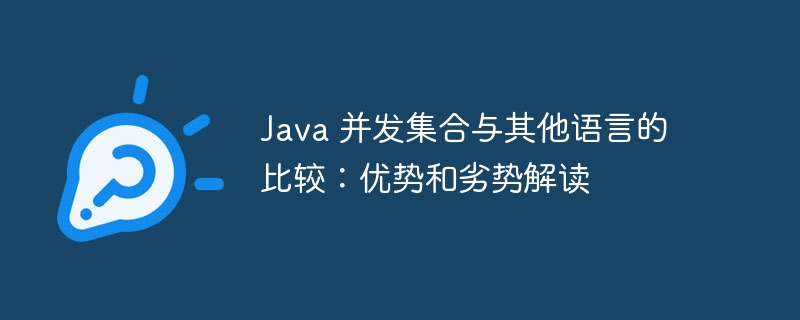Home >Java >javaTutorial >Java Concurrent Collections Compared to Other Languages: Advantages and Disadvantages Explained
Java Concurrent Collections Compared to Other Languages: Advantages and Disadvantages Explained
- 王林forward
- 2024-04-03 10:22:171192browse

- Thread Safety: ConcurrencyCollections are designed to be safely used in a multi-threaded environment, Prevent data races and inconsistencies.
- High performance: Concurrent collections utilize lock mechanisms and atomic operations to optimize performance, even in high concurrency scenarios. High throughput.
- Rich API: The Java concurrent collection library provides a rich series of classes and interfaces to meet the needs of various concurrency scenarios, such as queues, stacks, mapping and blocking collections.
- Wide support: Java concurrent collections are a must-have tool for Java developers, and all mainstream Java runtime environments have built-in support.
- Community Support: The Java community is active and strong, providing extensive documentation, tutorials, and code examples to support the use of concurrent collections.
- Performance overhead: Threads of concurrent collectionsThe security mechanism will introduce certain performance overhead, especially in low concurrency scenarios.
- Complexity: The api and implementation principles of concurrent collections are relatively complex, and developers need an in-depth understanding to use them correctly.
- Lock contention: If multiple threads compete for the same lock at the same time, it may cause deadlock or reduce performance.
- Limited functionality: Certain advanced concurrency features are missing from the Java concurrent collections library, such as lock-free data structures and non-blocking algorithms .
- Version Compatibility: There may be differences in concurrent collection implementations in different Java versions, which may cause cross-version application compatibility issues.
Comparison with other languages
C#:
- Advantages:C# The concurrency library provides a Java-like thread-safe collection and also supports lock-free data structures and asynchronous programming.
- Disadvantages: Lacks some advanced features in the Java concurrent collection library, such as blocking queues.
Python:
- Advantages: python’s parallel programming library GIL will force synchronization of all threads to ensure data security.
- Disadvantages: Performance may not be as good as Java concurrent collections, and GIL may limit the utilization of multi-core machines.
Go:
- Advantages: Go The language natively supports concurrency and provides mechanisms such as channels, coroutines, and mutexes, making it easy to build high-performance, scalable concurrent applications.
- Disadvantages: Lacks some specific collection types in the Java concurrent collection library, such as blocking queues.
Summarize:
Java concurrent collections provide thread safety, high performance, and rich APIs in a multi-threaded environment, but also introduce certain performance overhead and complexity. Compared with other languages, Java concurrency collections differ in performance and functionality, and developers need to choose the most appropriate language and concurrency library based on specific needs.The above is the detailed content of Java Concurrent Collections Compared to Other Languages: Advantages and Disadvantages Explained. For more information, please follow other related articles on the PHP Chinese website!
Statement:
This article is reproduced at:lsjlt.com. If there is any infringement, please contact admin@php.cn delete
Previous article:Java Syntax Guide: From Beginner to MasteryNext article:Java Syntax Guide: From Beginner to Mastery

